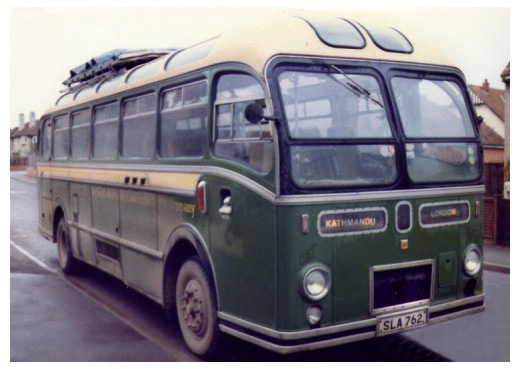The Bus

The AACCC fleet consisted of just one vehicle, the Bristol manufactured bus which Tim Harrison 'inherited' from the Asian Greyhound company when they went broke. Those on my trip called this bus Elsa after her registration number, SLA 762.
SLA 762 started life around 1953. Here is some information kindly supplied by Nigel Furness, author of the Bristol Buses web site.
"The SLA batch of Bristol LS6B coaches (which is what your coach is) were originally delivered to Tilling's Transport (BTC) Ltd. in 1953. Tilling were a direct descendant of Thomas Tilling who started operating in South London (Peckham) with horse buses in 1847.
The South London location explains the London registration mark LA. When Thomas Tilling Ltd was nationalized in 1948 the private hire business was put under the control of Eastern National for engineering but continued to operate as a separate business entity until 1974. Some vehicles were interchanged with Eastern National from time to time and your LS was one but it didn't stay with EN for very long, as far as I can make out.
Turning to the construction of the vehicle, surprisingly it is not made of wood, although there is a little wood here and there. In fact it is entirely aluminium, the framing being the new (in 1953) 'alusuisse' method of construction, extremely light weight (LS stood for 'Light Saloon') and as you note, extremely robust. It is entirely riveted, the only screws being used on the internal trim, the floor and the external beading. If you ever have to remove a panel then the first stage is to remove the beading at which point the construction becomes obvious. The floor is (or was) Canadian Redwood.
There is no chassis as such, again a new system of integral construction in which the under-frame (in this case steel) was manufactured as a light-weight perimeter frame work whose strength is derived from its attachment to the body. This makes it very unwise to separate the body from the under-frame on an LS as you may never get it back together again!"
SLA 762 had none of the extras that we take for granted today. The drum brakes had only a minimum of power assistance from the engine and there was no power steering or clutch. Top speed on level ground was 46 miles per hour, at which time the Gardener engine was turning over at a steady 2500 rpm. It was this leisurely pace which no doubt enabled her to survive so many miles over some the roughest surfaces that you can navigate a wheeled vehicle over. One of her advantages over more modern buses was that she was constructed with an aluminium frame with panels riveted rather than bolted.
I asked Tim one day if he wouldn't rather have a more modern bus but he pointed out that with such a simple and basic design, he could fix most problems himself virtually anywhere whereas a modern bus would need specialist skills and tools and would probably shake itself to pieces on the pot holed roads of Asia. I was saddened to hear that Tim was due to sell SLA 762 for scrap, such a sad end for a vehicle with so much history. Surely, covered in the red dust accumulated over more than a dozen return trips to Kathmandu, it deserved a place in one of the transport museums.

Last update: August 6th 2013 -
(The AACCC Website) - Author Nick Whetstone.
All rights Reserved.